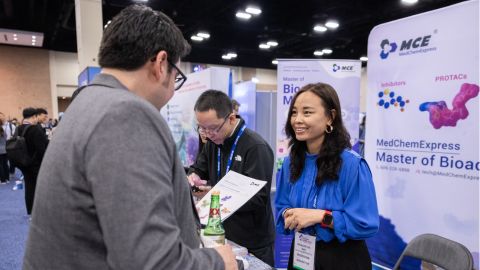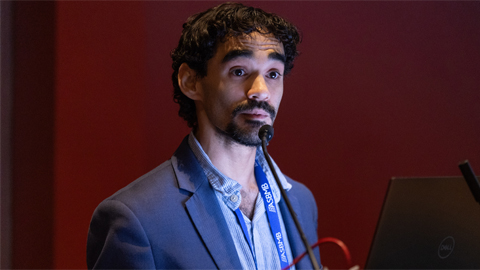
My story for LGBTQIA+ visibility in the life sciences
I grew up in rural southeastern Australia, which is an area of stunning natural beauty. Our house was set in natural bushland with lots of space to ride motor bikes and go exploring. I was fortunate to have parents who instilled in me a sense of discovery and of nature.
I was fascinated by the natural life-forms around me — especially the things I could get up close to. I caught small bugs and critters with my net to keep in an aquarium. In the nearby creek, I found fossils of small crustaceans and ferns that got me interested in evolution. I became obsessed with the ideas of continental drift and the ancient supercontinent of Gondwanaland. I was one of those kids who had every type of pet — guinea pigs, mice, aquarium fish, frogs, chickens — and I had my own little rainforest-themed garden. I was always interested in the science of biology, and I was good at school.
These were the key factors that gave me direction, and I ended up a professor in biochemistry.

An integral part of me, as of everyone, is my sexuality. I knew I was gay at a young age — probably around 11 or so, but it is hard to pin down the exact time I put two and two together. The world was blatantly homophobic back in the mid-1980s to early ’90s — it was the peak of the AIDS epidemic — but I was always sure that the way I felt was fundamentally normal despite a culture that pushed other ideas.
I was confronted from a very young age with the reality that the default templates for how to live life did not fit me. I was expected to marry a woman and have kids. And though my parents, friends and teachers were kind and sympathetic, they lacked firsthand experience of being gay, so even if they’d known, they couldn’t have provided me with alternatives.
For me, being gay was, as it probably was then for most gay teenagers, something to be kept totally secret. I knew no one who was openly gay. I lived in a rural region before the internet and with no gay support groups I knew of. Prevailing attitudes portrayed LGBTQIA+ people as nonexistent, sick or to be mocked. I was on my own, trying to imagine what my life might be like ahead.
Grappling with this isolation dominated my mind during my teenage years. By the age of 15, I no longer could stay silent, so I found the courage to talk to two people at school I trusted: a friend and a teacher. They encouraged me to come out to my parents. That was the hardest thing I have ever done in my life. Thankfully, those people at school and my parents were wonderful. Coming out was a big deal, but it didn’t change the fundamental issue of being on my own trying to learn about how to live my life.
After I finished school, I finally was in a position to begin to learn how to live as a gay man. Attending university meant moving to a big city where, for the first time, I met other LGBTQIA+ people.
During orientation week of 1993 at the University of Melbourne, I sought out the GaySoc society’s stall and encountered a group of enthusiastic students. I remember Bronski Beat was playing on a portable stereo in the background. I was so nervous to approach the stall, but the three people I talked to, Cameron, Marina and Damien, were just so warm and welcoming. They invited me to attend the regular lunchtime discussion groups they ran at the student union. It was the beginning of a new world, and it is no exaggeration to say I was like a kid in a candy shop from that moment on.
Lacking a template for living meant I had unbridled freedom to explore. I believe this freedom is a special privilege of our LGBTQIA+ community, but it took me more than a decade to work out how to harness it to be able to live my most rich and rewarding life. With so much choice, combined with my inexperience and a lack of role models, I didn’t know how to build meaningful connections beyond the shared experience of sexuality. I also felt a disconnect between what the gay world offered and my own personal interests — such as becoming a scientist.
In the academic world of biomedical sciences, we are lucky to work with educated and enlightened colleagues who generally have no problems with LGBTQIA+ people. But the lack of visible LGBTQIA+ scientist role models left me feeling alienated and fueled imposter syndrome during my graduate student and postdoc years.
The institute where I did my postdoc often hosted esteemed visiting scientists for seminars, and these visits included a lunch or dinner where postdocs could meet the guests in an informal setting. The institute worked hard to provide a diverse program of visitors, including many women and scientists from ethnic minority groups. The informal meetings led to fascinating discussions about many topics, especially personal perspectives on lives and careers. It was actually a very good program. But never were any of the guests openly LGBTQIA+.
People sometimes ask why sexuality matters in the context of life science research, considering our research is about testing hypotheses that generally are unconnected to the researchers’ sexuality. My answer is that it doesn’t matter at the direct level the questioner asks — but the lived experience of being gay creates a deeper imprint on self-identity that permeates all aspects of a person’s life, including their work life. Social discussions with colleagues occur through the prism of heterosexual assumptions as people talk about their wives or husbands or kids. Such small things form the social bonds that are important in networking and in career discussions about work–life balance. If I do bring up my partner in social discussions — even just very casually — the fact that my partner is male too often becomes the point of the discussion. Sometimes I am OK with that, but other times it is kind of tedious and can make me reluctant even to bring up the gender of my partner.
I am not setting a gay agenda by being assertive about this — indeed, I am uncomfortable about having to assert my sexuality anywhere, because it is a very personal thing. Rather, I am asking non-LGBTQIA+ people to think about the assumptions they might be making on topics they normally might not need to think too hard about. For example, assuming that a person they meet for the first time will have a partner of the opposite sex when asking social questions sets up barriers for people who are gay.
When an institution is establishing policies and a scope of inclusion is relevant, a well-intentioned inclusion policy that leaves out a minority group (either in wording or by action) can make the feeling of exclusion worse than if there were no policy at all. I have felt that many times in my life.
In my younger years, particularly in my early 20s to early 30s, I would have felt more comfortable and more a part of the scientific community if I had known more about others like me. My personal development would have benefited from having role models who shared my experience and whose example resonated with the whole of me — particularly LGBTQIA+ scientists who had successful careers and were inspiring and confident in their own skin without needing to be in the closet. Sure, I knew great gay people in the LGBTQIA+ community, and I knew great scientists — but I felt those two realms were generally parallel worlds. I know they shouldn’t be and are not really. I hope to provide a beacon to others who hunger for role models.
The world has become so much better in so many ways for the LGBTQIA+ community over the last two decades. I am writing this as Australia is abuzz with WorldPride celebrations in Sydney. The world definitely has come a long way, especially in the last decade. But we still can work to create beacons of visibility that showcase a wide variety of people who are scientists — this is relatively easy to do if you put yourself out there. The sexuality of many LGBTQIA+ people is invisible unless they put their hands up.
And thus, here I am — a full professor running a lab on the mechanisms of neurodegeneration. This is my story for visibility.
Enjoy reading ASBMB Today?
Become a member to receive the print edition four times a year and the digital edition monthly.
Learn moreGet the latest from ASBMB Today
Enter your email address, and we’ll send you a weekly email with recent articles, interviews and more.
Latest in Opinions
Opinions highlights or most popular articles

Hidden strengths of an autistic scientist
Navigating the world of scientific research as an autistic scientist comes with unique challenges —microaggressions, communication hurdles and the constant pressure to conform to social norms, postbaccalaureate student Taylor Stolberg writes.

Black excellence in biotech: Shaping the future of an industry
This Black History Month, we highlight the impact of DEI initiatives, trailblazing scientists and industry leaders working to create a more inclusive and scientific community. Discover how you can be part of the movement.

Attend ASBMB’s career and education fair
Attending the ASBMB career and education fair is a great way to explore new opportunities, make valuable connections and gain insights into potential career paths.

Benefits of attending a large scientific conference
Researchers have a lot of choices when it comes to conferences and symposia. A large conference like the ASBMB Annual Meeting offers myriad opportunities, such as poster sessions, top research talks, social events, workshops, vendor booths and more.

When Batman meets Poison Ivy
Jessica Desamero had learned to love science communication by the time she was challenged to explain the role of DNA secondary structure in halting cancer cell growth to an 8th-grade level audience.

The monopoly defined: Who holds the power of science communication?
“At the official competition, out of 12 presenters, only two were from R2 institutions, and the other 10 were from R1 institutions. And just two had distinguishable non-American accents.”

